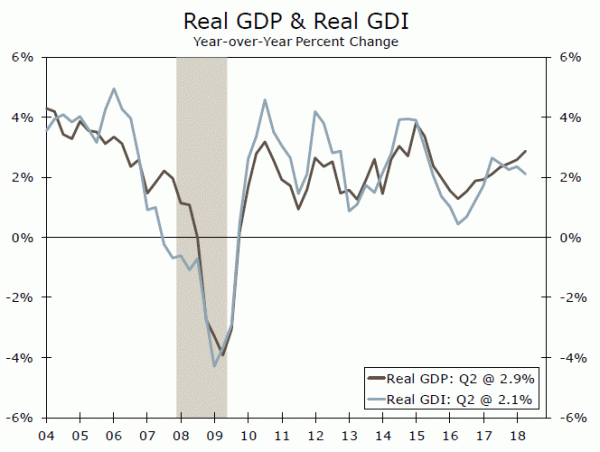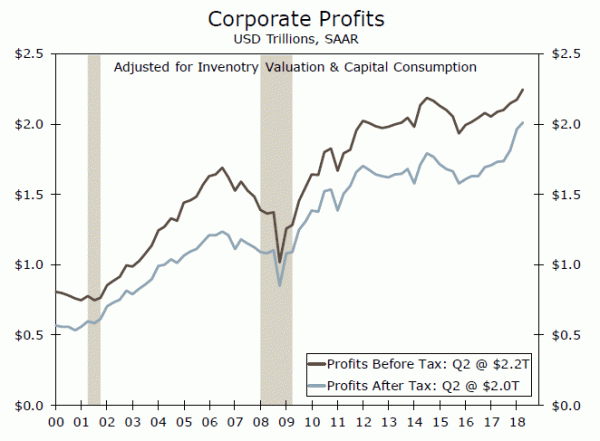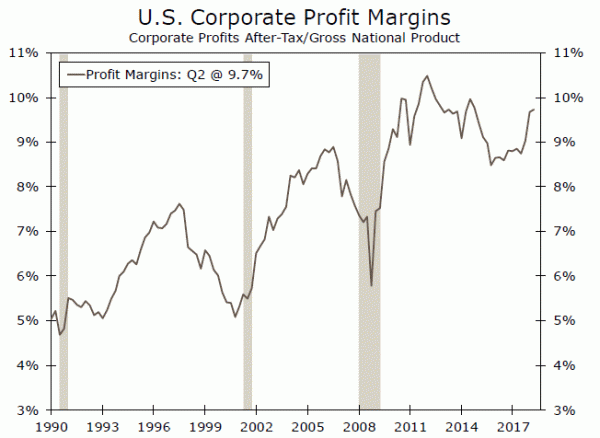The second estimate of Q2 GDP revised growth up to 4.2 percent. Corporate profits reached a historic high in the second quarter, supported by strength in real final sales and consumer spending.
Revisions to Trade and Software Spending Bump Up Q2 GDP Growing at a slightly faster pace than initially reported, real GDP rose at an annualized rate of 4.2 percent in Q2. As initially reported, consumer spending, business fixed investment and government spending each rose at a solid pace.
Business fixed investment, revised up 1.2 percentage points, led much of the upward revision, with intellectual property products growing 11.0 percent over the quarter. Similarly, a significant downward revision to import growth caused net exports to add a bit more to overall GDP growth.
Real gross domestic income (GDI) increased 1.8 percent in the second quarter, and is up 2.1 percent over the past year (top chart). In line with a tight labor market and rising incomes, the average of GDP and GDI is in line with expectations of about 3.0 percent growth this year.
Corporate Profits Reach a Historic High in the Second Quarter
With the second estimate of GDP we received our first look at corporate profit growth in the second quarter. Pre-tax profits grew $72.4 billion over the quarter, nudging the overall pre-tax profit level up to $2.2 trillion, a record high for the series (middle chart). However, after-tax profits rose only $47.3 billion, compared to the near $150 billion surge in the first quarter. This more modest increase was partially due to a rise of nearly one percentage point in the effective corporate tax rate. The deceleration in after-tax profits corroborates our forecast that the effect of the 2017 Tax Cuts and Jobs Act will only act as a temporary boost to corporate profit growth.
We look for corporate profits to continue to rise in the medium term, due to elevated levels of real final sales and business fixed investment. However, if the strength in equipment spending and intellectual property continues to only translate to modest improvements in productivity, it will likely exert a headwind to corporate profit growth in the future. Similarly, as the economic cycle continues to mature, increasing labor costs will squeeze corporate profit margins (bottom chart). Rising inflation also has the potential to limit real income gains, while higher interest rates may weigh on consumer spending–which would dampen real final sales, all else equal.
While this release was our first look at second quarter profit growth, the initial Q2 GDP release included a benchmark revision, which caused a downshift in the overall profit series throughout this expansion. The benchmark revisions, as well as the larger-than-expected gain in before-tax profits, will likely cause us to bump up our corporate profits forecast.
We have found that pre-tax profits traditionally peak about five-to-eight quarters prior to a recession. While we are not expecting a recession in our forecast horizon, we will continue to monitor signs of a peak in the profits series, and adjust our forecast accordingly.

















